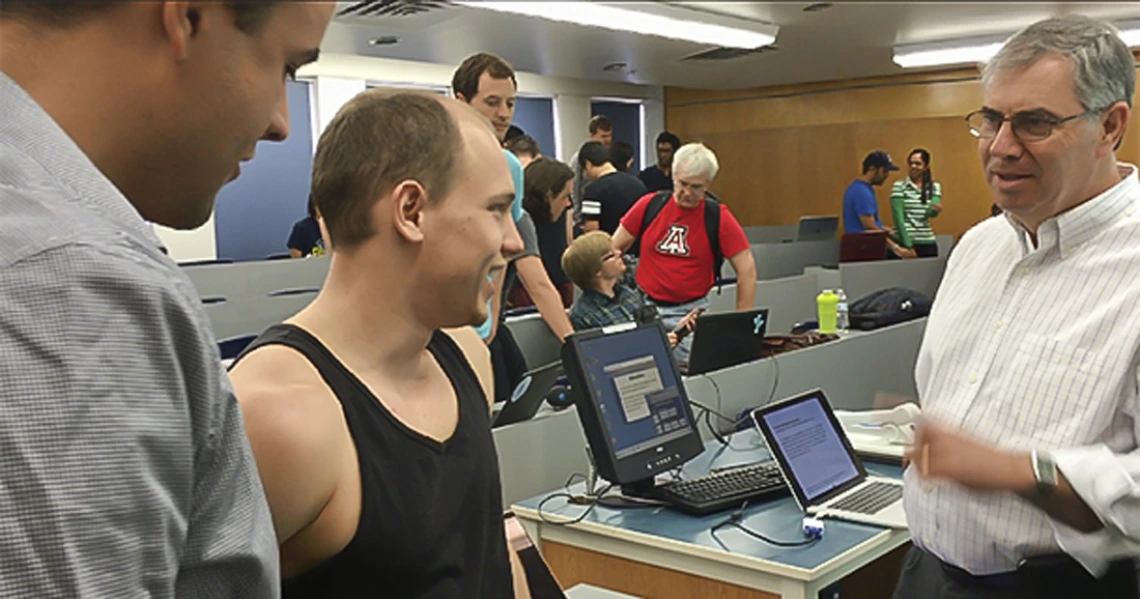ECE Student Apps Are Putting an End to Everyday Annoyances
With the mobile apps University of Arizona students are developing in associate professor Jonathan Sprinkle’s software engineering class, users might never get another parking ticket, fumble a PowerPoint presentation or miss an important meeting.

Students in ECE associate professor Jonathan Sprinkle's Software Engineering Concepts class demo their apps to College of Engineering Dean Jeff Goldberg (right), faculty, staff and students.
More sleep, fewer cellphone interruptions, pothole-free driving, better time and medication management: There are apps for that, and students at the University of Arizona built them.
Small groups of students from associate professor Jonathan Sprinkle’s upper-level Software Engineering Concepts class presented nearly 20 apps -- most designed to make life easier -- for their final projects on May 4.
Many students looked to annoyances and inconveniences in their own lives for inspiration.
Pothole Avoidance
Roads in Tucson, Arizona, are known for their abundant potholes, and one team had had enough of the shake, rattle and roll.
“As a Tucson driver, I encounter potholes all the time, so our team set out to develop an app that makes them easy to find and even easier to avoid,” said programmer Jacob Dorer, whose teammates included Adley Gin and Phillip Gotobed.
The app records road conditions and maps potholes in real time, then alerts drivers of previously logged pothole locations.
Sleep Apnea Detection
Sleep apnea is a common and serious medical condition that diminishes sleep and can lead to high blood pressure, heart disease, stroke and diabetes. Yet many people go undiagnosed and untreated.
Diagnosing the condition usually involves costly overnight sleep studies. Brandon Lipjanic, Bryan Rogers and Spencer Lee created APPnea. The app uses a smartphone’s microphone to record snoring and sporadic long pauses in a sleeper’s breathing, which may indicate obstructive sleep apnea, and charts results.
“The app is not a replacement for an actual sleep study,” said Lipjanic, “but it provides an inexpensive first step to see if the person may need to see a sleep specialist.”
Keyboard-Free Presentations
Timing a PowerPoint presentation just right can be tricky when a presenter is operating a clicker or using a keyboard to advance slides.
Ehsan Esmaili and Amrutha Gajula’s app uses pre-programmed gestures detected by smartwatches to control slides in PowerPoint presentations. It also sets alerts to manage presentation timing.
No Caddy? No Problem
Bunkers, trees and ponds can be difficult for fledgling golfers to negotiate, especially without a caddy.
An app designed by Thomas May, Steve Murrell and Kyle Walker fills in for caddies. It applies probability and statistics to yardage, hazards and tee shots to help golfers choose the best clubs and take their best next shot.
“It can get you close to where you are trying to get,” said Murrell. “With enough practice, you can sink that hole like a champ.”
Solutions to Make Life Easier
Parking Runner, developed by Phillip Showers and Rubi Ballesteros, uses a phone’s built-in navigation system to calculate location and walking speed so users can head back to their cars before their meters run out.
Don’t Bother Me, courtesy of Jake Boucher, Seth Werly and Steven Wirth, keeps unwanted calls and text messages at bay. It monitors and reads aloud the names of people sending calls and texts; then, responding to recipients’ gestures, the app puts callers on speakerphone, reads aloud messages or sends auto replies.
Other apps tap into smartphone GPS systems, cameras, microphones and voice recognition programs to create detailed medication lists, a dashboard for driverless cars, an exercise performance monitor, file encryption systems, a smart alarm clock, a Wi-Fi connection toolkit and a musical instrument tuner.
Programmers Learn to Put Customer First
The entrepreneurial course requires students to go beyond adaptation of a mobile device’s existing information, test their software under real-world conditions, and perhaps most importantly, consider what the customer wants.
“They must use of one or more of the phone’s sensors to make the phone do something it couldn’t do before,” said Sprinkle, the Litton Industries John M. Leonis Distinguished Associate Professor. “Students are required to create apps that have potential for commercialization.”

